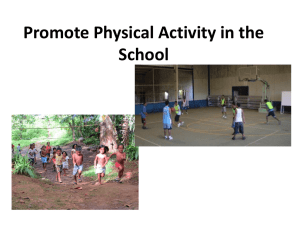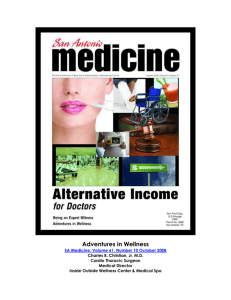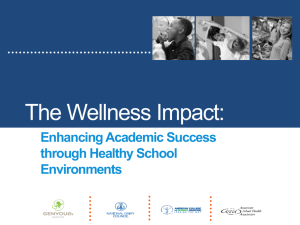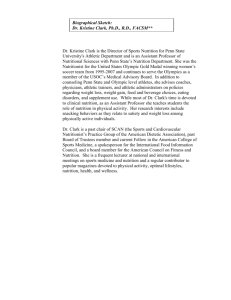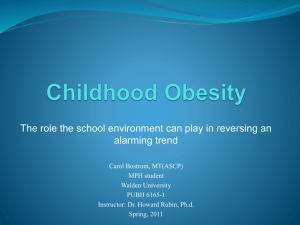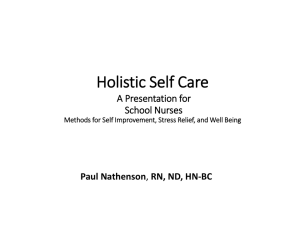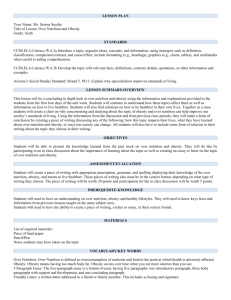School-based Physical Activity and Physical Education
advertisement
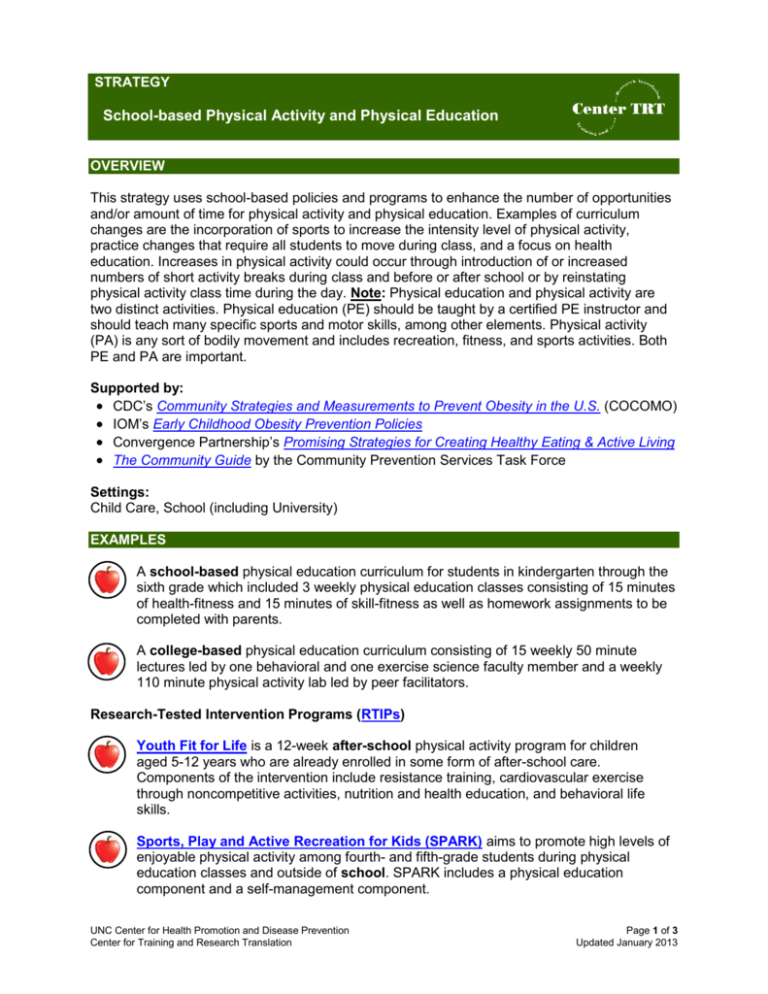
STRATEGY School-based Physical Activity and Physical Education OVERVIEW This strategy uses school-based policies and programs to enhance the number of opportunities and/or amount of time for physical activity and physical education. Examples of curriculum changes are the incorporation of sports to increase the intensity level of physical activity, practice changes that require all students to move during class, and a focus on health education. Increases in physical activity could occur through introduction of or increased numbers of short activity breaks during class and before or after school or by reinstating physical activity class time during the day. Note: Physical education and physical activity are two distinct activities. Physical education (PE) should be taught by a certified PE instructor and should teach many specific sports and motor skills, among other elements. Physical activity (PA) is any sort of bodily movement and includes recreation, fitness, and sports activities. Both PE and PA are important. Supported by: CDC’s Community Strategies and Measurements to Prevent Obesity in the U.S. (COCOMO) IOM’s Early Childhood Obesity Prevention Policies Convergence Partnership’s Promising Strategies for Creating Healthy Eating & Active Living The Community Guide by the Community Prevention Services Task Force Settings: Child Care, School (including University) EXAMPLES A school-based physical education curriculum for students in kindergarten through the sixth grade which included 3 weekly physical education classes consisting of 15 minutes of health-fitness and 15 minutes of skill-fitness as well as homework assignments to be completed with parents. A college-based physical education curriculum consisting of 15 weekly 50 minute lectures led by one behavioral and one exercise science faculty member and a weekly 110 minute physical activity lab led by peer facilitators. Research-Tested Intervention Programs (RTIPs) Youth Fit for Life is a 12-week after-school physical activity program for children aged 5-12 years who are already enrolled in some form of after-school care. Components of the intervention include resistance training, cardiovascular exercise through noncompetitive activities, nutrition and health education, and behavioral life skills. Sports, Play and Active Recreation for Kids (SPARK) aims to promote high levels of enjoyable physical activity among fourth- and fifth-grade students during physical education classes and outside of school. SPARK includes a physical education component and a self-management component. UNC Center for Health Promotion and Disease Prevention Center for Training and Research Translation Page 1 of 3 Updated January 2013 TRT REVIEWED INTERVENTIONS ABC Grow Healthy (South Carolina) for child care centers Nutrition and Physical Activity Self-Assessment for Child Care (NAP SACC) RESOURCES AND TOOLS SCHOOL Wellness Policy Tool (Action for Healthy Kids) This web-based tool helps guide the development of a school wellness policy by dividing the process into eight steps. Each step includes objectives, sample language, critical information, online resource links, and FAQ from a virtual wellness policy team. Physical Education Curriculum Analysis Tool (CDC) This tool is designed to help educators assess the alignment of written curricula and practice with national standards, guidelines, and best practices for physical education programs. Also, the resource provides guidance, suggestions, and useful materials for improving school programs based on assessment results. Resources to Improve Schools (Action for Healthy Kids) This is a collection of resources and tools designed to help schools encourage healthy eating. It includes a database searchable by topic, audience, material type, target age, partner, and/or state. Information is provided on vending/snacks, a la carte foods, wellness policies, coordinated school health policies, marketing, and nutrition education under the “food at school” topic. Healthy Schools Program Resources and Tools (Alliance for a Healthier Generation) This program was developed to provide on-site and web-based support and tools for implementing programs and policies that promote physical activity and healthy eating. Tools provided include an extensive resource database, training resources and programs, and essential physical activity and nutrition program information for schools. Planet Health (Harvard School of Public Health) This complete curriculum helps academic, physical education, and health education teachers guide middle school students in learning about nutrition and physical activity, while building skills in language arts, math, science, and social studies. The curriculum includes understanding how health behaviors are interrelated, choosing healthy foods, increasing physical activity, and limiting TV and other screen time. Materials must be purchased. Eat Well and Keep Moving (Harvard School of Public Health) This curriculum is similar to Planet Health, but it is directed toward a slightly younger age group and focused on upper elementary school age students. This curriculum prepares teachers to incorporate nutrition and physical activity into language arts, math, science, and social studies lessons. The goals of the program are to help students choose healthy foods, increase physical activity, and limit TV and other screen time. Materials must be purchased. UNC Center for Health Promotion and Disease Prevention Center for Training and Research Translation Page 2 of 3 Updated January 2013 Playworks Playbook (Playworks) This resource emphasizes that recess and play are essential to child development, improve the school climate, and help children return to the classroom more focused and ready to learn. Playworks’ playbook for teachers includes ideas for recess including Ice Breakers, Building Sports Readiness, Tag Games, Cooperative Games, and others. REFERENCES Committee on Obesity Prevention Policies for Young Children, & Institute of Medicine (IOM). (2011). Early Childhood Obesity Prevention Policies. Washington, D.C.: The National Academies Press. Retrieved April 24, 2012, from http://www.nap.edu/catalog.php?record_id=13124. Khan, L., Sobush, K., Keener, D., Goodman, K., Lowry, A., Kakietek, J., & Zaro, S. (2009). Recommended Community Strategies and Measurements to Prevent Obesity in the United States (COCOMO) Morbidity and Mortality Weekly Report (MMWR) Recommendations and Reports (pp. 26). Atlanta, GA: Centers for Disease Control and Prevention. Retrieved April 24, 2012, from http://www.cdc.gov/mmwr/preview/mmwrhtml/rr5807a1.htm. Prevention Institute. (2008). Promising Strategies for Creating Healthy Eating and Active Living Environments (pp. 16). Retrieved April 24, 2012, from http://www.convergencepartnership.org. The Community Preventive Services Task Force. (29 March 2012). The Guide to Community Preventive Services (The Community Guide) Retrieved April 24, 2012, from http://www.thecommunityguide.org/index.html. UNC Center for Health Promotion and Disease Prevention Center for Training and Research Translation Page 3 of 3 Updated January 2013


